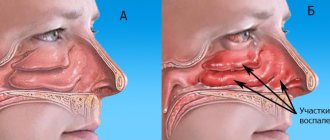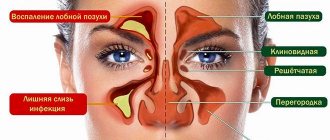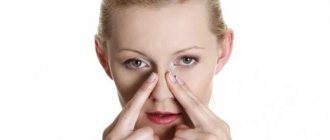Main causes and associated symptoms
If the nose itches on the outside, this may be caused by various pathological skin processes, damage to the integrity of the integument, or insect bites.
In pathological skin processes of an infectious or allergic nature, itching and burning usually occur in the area of the wings of the nose. This is caused by factors such as:
- Scabies. The causative agent of the disease is the scabies mite, which moves under the skin and thus irritates it. The severity of unpleasant sensations increases in the evening and at night, since it is during this period that the microscopic parasite is activated. In addition to itching, redness, ulcers, and rash are observed;
- Sycosis of the nasal vestibule. This is a pustular disease in which inflammation of the follicle occurs. The development of pathology is caused by Staphylococcus aureus. When the pustules located in the areas of the hair shafts are opened, their contents spill onto the surface of the skin, forming dry crusts. With nasal sycosis, the skin becomes inflamed, burning and itching appears;
- Eczema of the nose. The disease is inflammatory in nature and spreads in most cases to the skin of the wings of the nose. In addition to severe itching, severe pain appears when palpating the nose;
- Dermatosis. Pathology develops with the activation of pathogenic microflora. In the case of dermatosis, not only the outside of the nose itches, but also the area of the nasolabial fold.
Photos of the symptoms of the disease. May be unpleasant to watch
The cause of itching of the outer part of the nose is not only a disease.
Also, a similar phenomenon can occur due to insect bites.
Usually these are blood-sucking parasites - mosquitoes, ticks, bedbugs, fleas. They do not release poison into the layers of the skin, but cause severe irritation, and sometimes redness and severe swelling of the tissue. A characteristic sign that the bite was made by a tick is the presence of a lump under the skin.
Stinging arthropods - wasps, bees, hornets - can also cause itching of the skin of the nose. This is due to the fact that when they bite, such insects release poison into the soft tissues. This provokes the development of an allergic reaction. In addition to itching, pain appears and swelling develops.
If the body is hypersensitive to insect poisons, the body temperature may rise and a severe allergic reaction may develop, including Quincke's edema.
Injuries to the nose, as a result of which the integrity of the epithelium is disrupted, is another reason why the skin in this area itches. When cuts or blows occur, the body reacts with increased production of histamine, a substance that promotes rapid tissue restoration. This element irritates nerve receptors, contributing to the appearance of itching.
Treatment
Therapy directly depends on the diagnosis.
Depending on the reasons, antifungal and anti-inflammatory drugs and antibiotics can relieve irritation. In addition, the doctor has the right to prescribe additional medications and procedures, and do additional examinations.
In some cases, medications may not help, and then you have to resort to surgery.
In any case, it is not advisable to start treatment yourself.
A burning sensation in the nose is rarely associated with something serious; most often it is a sign of an allergy or an incipient runny nose. The following will help reduce the severity of symptoms:
- Rinse the nose with a 1% solution of table salt or pharmaceutical preparations with sea water. The liquid washes away pathogens, allergens, and dust from the surface of the mucous membrane, improving its functioning.
- Maintaining sufficient humidity in the room, especially in the children's room. To do this, you can use a special device or simply containers with liquid that are placed in the battery area. There is maximum water evaporation.
- If there are crusts, soften them with Vaseline oil applied to a cotton swab. It is especially important to carry out such measures in infants, since crusts seriously impede their breathing, which prevents normal food intake. As a result, the child does not eat enough, sleeps poorly, is capricious, and cries a lot.
- In the absence of fever and purulent discharge, warming of the nose and sinuses. This can be done using inhalations or compresses. A bath with essential oils is beneficial. Mint and menthol have a cooling effect and relieve burning sensation.
- If the burning sensation is associated with heavy discharge, vasoconstrictor medications will help relieve the symptom. However, you should not abuse them. Taking it for more than a week can lead to atrophy of the nasal mucosa.
If the cause of the disease is discovered, the doctor may prescribe the following medications:
- Antibiotics. They destroy pathogenic bacteria and fungi that cause colds. The best solution is to take local medications, such as Isofra or Polydexa, which do not have a harmful effect on the beneficial intestinal microflora. General antibiotics are prescribed only if the former are ineffective.
- Immunostimulants. If it turns out that the symptom began with a reduced immune status, taking them will be mandatory. Some experts recommend their use for the prevention of colds.
- Antiviral drugs. They will help with flu and similar infections. They inhibit the reproduction of the virus or its release from the cells of the human body. Many such drugs have a wide range of side effects, so they are not prescribed for mild infections.
- Antihistamines. These medications relieve allergy symptoms. If your nose and eyes are very itchy, you can take Suprastin or Fenistil on your own.
The following can be used as therapeutic measures:
- Physiotherapy. A number of drugs penetrate the body more intensively under the combined action of electric current. Laser and magnetic radiation are also used. The Azor-IK device, in particular, is suitable for professional and home use. Its instructions state that it has “universality of therapeutic action and the absence of harmful side effects.”
- Cauterization. If there are non-healing ulcers, persistent swelling or areas of severe destruction of the mucous membrane in the nasal cavity, such a measure can start regeneration processes. As a result of the procedure, tissue is often removed and the edges of the wound are sealed.
- Operation. It is prescribed for deformities of the nasal septum and serious atrophy of the mucous membrane. The operation is performed under general anesthesia in a hospital setting. For breathing problems, it is prescribed from the age of six, but it is optimally carried out after 14-16 years.
Causes of itching inside the nasal passages
The mucous membrane becomes irritated and itchy due to factors such as:
- Allergic reaction of the body. When contact occurs with an allergen, which can be plant pollen, cosmetics, or animal fur, inflammation of the skin layers occurs. With allergies, not only the outer part of the nose itches, but also the inner mucous membrane. In addition, nasal congestion, redness of the eyes, a runny nose and constant sneezing begin;
- Drying of the mucous membrane. This can happen as a result of unfavorable weather conditions and climate. Also, the mucous membrane dries out due to insufficient air humidity in the room or prolonged use of vasoconstrictor nasal agents. Under such conditions, the vessels become more fragile, so there is a possibility of developing nosebleeds;
- Colds, rhinitis of infectious origin. As a result of the activity of pathogenic microorganisms, the nasal mucosa is irritated. The situation is aggravated by the fact that to eliminate nasal congestion, vasoconstrictor drops are used several times a day, which dries out the membrane. In addition to itching, there is a runny nose, coughing attacks, sore throat and sore throat;
- Hypothyroidism. Thyroid dysfunction causes severe itching, which is associated with increased blood flow and increased skin temperature. In addition, with hypothyroidism, as with other diseases of the endocrine system, patients suffer from increased dryness of the skin and mucous membranes, which also causes itching, in particular in the nasal area;
- Congenital or acquired anomaly - curvature of the nasal septum, development of tumors, polyps in the nasal cavity;
- Psychogenic reaction. The inside of the nose can itch in those who are in a constant state of nervous tension, stress, or increased anxiety. Under such conditions, the amount of mediators in the blood that provoke itching increases;
- Hypertrichosis. This problem is caused by excess hair growth, including inside the nasal passages. A large number of hairs prick the nasal mucosa, creating a feeling of discomfort.
There are many reasons why your nose may itch inside and outside.
It is possible to reliably determine what was the impetus for this only with the help of diagnostic measures.
Diseases accompanied by itching
In most cases, the desire to scratch your nose is associated with some pathological process in the body. If your nose is very itchy, the reasons for this phenomenon are most often the following:
- Acute respiratory viral infections, simply put, are colds. The development of the inflammatory process and the resulting nasal congestion become factors that provoke the development of these symptoms.
- Infectious processes caused by mycotic skin lesions (fungus). As a rule, they arise due to decreased immunity, as well as an imbalance of microflora in the body (this is provoked by taking antibacterial drugs).
- Taking into account the fact that there are a large number of hair follicles in the nose, if at least one of them becomes infected, severe itching and pain will be observed in the affected area, and there will be a desire to scratch the outer surface.
- As a result of the burn of the nasal mucosa, its atrophy is formed. This leads to a lack of adequate secretion and hydration of the mucous membrane. Factors that cause its atrophy are not only burns, but also trauma, surgery, smoking and anemia. The hereditary factor is also of great importance in this situation. The skin over the entire surface of the nose will itch - these are the features of the innervation.
- Allergic reactions, which include rhinitis, hay fever and hay fever. The bottom line is that in an allergy sufferer a characteristic reaction is caused by a substance to which a healthy body would not react at all.
- Iatrogenic (medicinal) causes. Here we are not considering the case where the administration of one drug provokes the development of itching, but the effect caused by the accumulation of biochemically active substances in the human body. Such situations arise during self-medication, when a person arbitrarily prescribes a large number of sprays and drops and takes them uncontrollably.
When the nose itches, symptoms may differ in patients with similar causes of the disease.
Diagnostics
A patient with complaints of itching in the nose or on its surface is prescribed the following diagnostic measures:
- taking anamnesis;
- palpation of lymph nodes;
- general blood analysis;
- dermoscopic examination;
- study of hormonal characteristics;
- culture of nasal discharge;
- consultations with specialized specialists – allergist, endocrinologist, ENT doctor.
The determination of the course of treatment depends on what disease that caused the constant itching in the nose was identified in the patient.
Nasal rinsing
This procedure allows you to clean the inner walls of the nasal passages from mucous accumulations and pathogenic microorganisms. Regular rinsing prevents excessive drying of the nasal mucosa and the formation of crusts. You can rinse the nasal passages with saline solution or special pharmaceutical products containing sea water and salt.
The best medications for washing are:
- "Aquamaris";
- "Humer";
- "Marimer";
- "Salin";
- "Dolphin"
To prepare your own saline solution, you need to take a spoonful of table salt and dissolve it in a glass of warm water. The procedure should be performed 5-6 times a day.
Treatment options
If the nose itches, the patient may be prescribed the following medications:
- Antihistamines (Claritin, Zodak). They are suitable if the itching was caused by an allergic reaction;
- Vasoconstrictor drops and sprays – Xylene, Naphthyzin. These drugs are recommended for colds and rhinitis;
- Phytodrops (Pinosol). Such agents act more gently on the mucous membrane than vasoconstrictors, since they contain natural components;
- Corticosteroids. These are hormonal drugs that are prescribed if the itching was caused by a dysfunction of the endocrine organs (Nazarene, Benarine);
- Wash solutions (Humer, Salin, Aqua-Maris). These products are suitable for improving the condition of the mucous membrane, which is dry due to external factors or the uncontrolled use of vasoconstrictor drops;
- Antiseptics. They are advisable to use when bacteria penetrate the nasal cavity. In such cases, Albucid, Chlorophyllipt are prescribed;
- Antiviral, affecting pathogenic microorganisms and eliminating them (Interferon);
- Antibiotics. Drugs of this pharmaceutical group are prescribed for the treatment of infectious diseases of the respiratory tract (Amoxiclav, Nystatin, Azithromycin).
In addition to medications, there are traditional methods for eliminating itching in the nose or on its surface. The most common are:
- Lubricating the nasal passages with Vaseline oil. It must be applied very carefully using a cotton swab.
- Warming up the sinuses. This method can be used only if the patient does not have a fever and there is no purulent discharge from the nose. To carry out the procedure, you should breathe steam over a bowl of hot water to which essential oils have been added.
- Rinse the nose with saline solution. It is best to take sea salt (1 teaspoon per glass of warm water).
- Taking herbal infusions. This remedy will help cope with itching, which is of a nervous nature, as it has a mild soothing effect. To prepare, you can take lemon balm or mint, chamomile flowers, motherwort, brew with boiling water, let it brew for half an hour and take.
Also, if there is severe itching in the nose, you can use homeopathic remedies.
Such remedies as Scylla, Dulcamara, Arsenum Album, Bromine help relieve itching and burning.
Infectious diseases
Frequent colds are the first sign of a weakened immune system. This is an indicator that the immune system cannot cope with its functions, so the body easily succumbs to infections.
The incubation period of this disease is about 48 hours, after which the first symptoms begin to appear: the patient's eyes itch, the nose is stuffy, and sneezing.
A runny nose and sneezing are easily explained by inflammation of the respiratory system, but why does itchy eyes occur? In case of respiratory diseases (acute respiratory infections, acute respiratory viral infections), influenza, the patient may develop infectious conjunctivitis as a concomitant disease.
Its appearance can be provoked by both weakened immunity and neglect of sanitary and hygienic standards. For example, an infection can get into your eyes if you rub them with dirty hands.
To confirm the presence of infectious conjunctivitis, you must be examined by an ophthalmologist. When conjunctivitis develops against the background of a cold, the patient may experience the following symptoms:
- sneezing;
- cough;
- inflammation of the respiratory system;
- itching, redness and irritation of the eyes;
- tearfulness;
- photophobia;
- prostration;
- increased fatigue;
- dizziness;
- high body temperature.
To get rid of symptoms, you must fight the infection. The doctor prescribes medications for general and symptomatic action, antiviral and anti-inflammatory drugs, vasoconstrictor drops, which help remove redness of the eyes and relieve swelling of the nasal mucosa.
The patient is recommended maintenance therapy: plenty of warm drinks, bed rest, rinsing, washing (herbal infusions, alkaline, saline solutions).
Prevention
To prevent the occurrence of unpleasant symptoms such as burning and itching in the nose, you should:
- observe hygiene standards;
- temper yourself, as well as strengthen the body with other methods (vitamin therapy, sports);
- wear personal protective equipment if work activity is related to chemical production;
- use vasoconstrictor drops only in exceptional cases, avoiding addiction;
- quit smoking and other bad habits;
- maintain the required level of humidity in living rooms, regularly and thoroughly wipe dust from surfaces;
- During the cold season, use masks.
Of great importance is the timely completion of preventive examinations, during which pathologies can be detected in the early stages of development.
Scabies
This parasitic disease is manifested by extensive damage to the epidermis.
The causative agent is a microscopic mite - scabies itch. The parasite itself is not visible to the naked eye, but the passages it gnaws are clearly visible on the skin. When the insect moves in the skin layers, the person experiences unbearable itching.
The activity of the tick is uneven: the female lays eggs mainly in autumn and winter, the parasite is awake at night and rests during the day. Therefore, the most intense itching is observed at night during the cold seasons of the year.
Scabies is picky in choosing its habitat; it prefers to settle on delicate and soft parts of the skin. The lifespan of the parasite is about two weeks, a week in high humidity. You can get an infection through close contact with a sick person without following hygiene rules.
In order to never encounter scabies mites, it is enough to use the shower daily and, if necessary, wash your hands with soap.
Scabies symptoms are similar to an allergic reaction. The parasitic disease is accompanied by the appearance of a rash in the form of red dots on the skin. An unbearable itching is felt in the place where the parasite lives; the sick person constantly scratches the skin, tearing it until it bleeds.
Scabies, unlike allergies, does not cause a runny nose or excessive watery eyes.
Folk signs
People associate itching in the nose not only with diseases: there are many signs associated with this phenomenon. There is an opinion that the nose “senses” all the events that are about to happen in the near future. Here are a few of these signs:
- If the tip of the nose itches, then, as was previously believed, this indicates an approaching cheerful feast with friends. It may also indicate easy profits in the near future.
- If your nostril itches, then it matters a lot whether it is the left or the right. In the first case, itching promises quick troubles and troubles. If the right nostril itches, then pleasant events, gifts, and pleasures await the person in the near future.
- If your whole nose itches, both inside and outside, then you shouldn’t expect anything good. In this case, the person will face quarrels, perhaps even fights, a reprimand from his superiors.
- The wings of the nose itch, according to beliefs, to troubles of any kind: health problems, financial problems or difficulties in relationships.
The cause of an itchy nose may be the presence of diseases, damage to the skin or mucous membranes, or bites of blood-sucking or poisonous insects. You can get rid of the unpleasant sensation with the help of medications or folk remedies. For the purpose of prevention, it is necessary to promptly treat existing diseases, protect yourself from the effects of chemicals and dust, and maintain an optimal level of humidity in the living room.
Microbial rhinitis
The causes of nasal itching can be either infectious or viral.
It is impossible not to mention fungal infection and allergies, as well as some other causes of itching: inflammation of the hair follicles, the presence of a foreign object in the nasal sinuses, atrophy, excessive consumption of vasoconstrictors, deviated septum, neoplasms.
The causes of an itchy nose may be due to infection in the body. Despite the every second attack of the mucous membrane by pathogenic microorganisms, diseases develop extremely rarely. The fact is that local immunity protects the mucous membrane from infection.
When does the risk of infection increase?
- with immunodeficiency caused by severe systemic infection, somatic diseases or congenital pathology;
- due to prolonged inhalation of cold air. Against this background, a spasm of the blood vessels of the nasopharynx occurs, the delivery of immune components deteriorates, tissue nutrition is disrupted, and dry mucous membranes appear. She becomes more sensitive to microbes. Itchy sensations occur due to irritation of the mucous membrane by pathogenic microorganisms;
- with long-term use of intranasal drops with a vasoconstrictor effect. The action of the drugs is to provide vasospasm. Reducing the diameter of blood vessels at the site of drug administration leads to a decrease in the severity of rhinorrhea and tissue swelling.
Symptoms
Clinical manifestations of microbial rhinitis include:
- itching in the nose;
- sneezing;
- mucous rhinorrhea, which gradually gives way to thick discharge with a yellowish tint;
- hyperthermia (the level of fever depends on the type of pathogenic microorganisms);
- nasal congestion caused by tissue swelling;
- difficulty breathing through the nose;
- lack of smell.
Due to frequent friction of the wings of the nose, the skin of this area begins to peel off, turn red, and microcracks appear. They cause pain and become entry points for infection.
Rhinitis goes through several stages, each characterized by its own symptoms:
- At the first stage, the nose begins to itch. In addition to internal itching, lacrimation and slight rhinorrhea are disturbing;
- the second is characterized by the release of mucus in a large volume and the absence of nasal breathing;
- the third stage is the final stage, when the discharge becomes thick and gradually disappears.
To remove itching in the nose and other symptoms of infectious rhinitis, it is necessary to influence the cause of the disease. For this purpose the following may be prescribed:
- antibacterial agents, for example, Isofra, Bioparox. They are administered locally. In case of complicated course of the disease, systemic antibiotics (Amoxicillin, Sumamed) can be used;
- antiseptic preparations for washing the nasal passages (Furacillin, Dekasan);
- antiviral medications for nasal administration, for example, Grippferon. The drugs stimulate the production of interferons to strengthen the immune system;
- tableted antiviral drugs, for example, Amiksin, Groprinosin.
To combat rhinorrhea you can use:
- vasoconstrictor medications, such as Lazorin, Snoop, Tizin. They are prescribed in a short course of up to 5 days;
- saline solutions (Aqua Maris), which are used to rinse the nasal passages.
Traditional methods
If your nose itches, you can use folk remedies:
- inhalations with onions and garlic. To do this, you need to grind the ingredients, wrap it in a scarf and inhale the aroma for 10 minutes. Inhalations can also be carried out with horseradish. It should be crushed, placed in a sealed container and left in the refrigerator. Every 90 minutes you need to take 5-6 breaths of horseradish aromas;
- nasal drops. First, you should peel, chop the onion and garlic, and squeeze out the juice. To eucalyptus oil (5 drops) you need to add a drop of garlic juice or a couple of drops of onion juice;
- aloe juice To obtain a healing medicine, you need to cut the plant, peel it, wrap it in a dark cloth and leave it in the refrigerator for half a day. Then you need to squeeze out the juice and drop drops into your nasal passages. In some cases, it is recommended to dilute the juice with boiled water to obtain a 50% concentration.
If a person does not have an elevated body temperature, but has rhinitis, sneezing and itchy eyes, one may suspect an allergic reaction to some irritant. Since the manifestations of hypersensitivity are very individual, it is difficult to determine at home which allergen causes unpleasant symptoms.
These allergens may include:
- plant pollen;
- fungal spores;
- wool, animal dander;
- Food;
- cosmetical tools;
- dust mites;
- household chemicals, etc.
Each person's reaction to the same substance that causes an allergy may manifest itself differently. This is influenced by the following factors: individual parameters of a person (age, height, weight), duration of action of the substance and the amount of allergen.
In addition to the fact that a person has rhinitis, itchy eyes and sneezing, other symptoms of increased sensitization of the body may also be observed:
- hives;
- dermatitis;
- swelling;
- redness, irritation of the eyes;
- attacks of suffocation, etc.
Almost all manifestations of allergic reactions are treated with antihistamines; rarely, if a person rapidly develops severe manifestations of the disease (asthmatic attack, anaphylactic shock), hormonal treatment is used.
It is very important to get rid of the source that causes the allergy. People suffering from this disease should be very careful when choosing clothing and food, carefully monitor the cleanliness of the room in which they are located, and strengthen their immunity.
Homeopathic treatment of the problem
If the itching is caused by irritation of the mucous membrane due to a cold, the following medications are suitable:
- Cinnabsin – relieves inflammation and has an antimicrobial effect.
- Coryzalia – relieves swelling, helps reduce discharge, and has an antibacterial effect.
- Allergic reactions (including sun allergies) can be dealt with using the drug in the form of homeopathic drops Allergonix .
Antihelminthic drugs:
- Intexic Plus - drops not only fight against helminthic infestation, but also help restore damaged tissue; the drug has a pronounced regenerating effect.
- Cina is an anthelmintic that restores the mucous membrane.
- Granatum – effectively cleanses the child’s body and is safe for the young body.
If the cause is a runny nose:
- Sabadilla - effective in treating runny nose.
- Silicea – relieves swelling and has an antibacterial effect.
- Sulfur an antibacterial effect.
- Teucrium – copes with allergies, relieves swelling.
- Viola odorata is an antibacterial and sedative.
Mezereum 6c (Mezereum, Daphne mezereum) helps with the manifestations of eczema .








